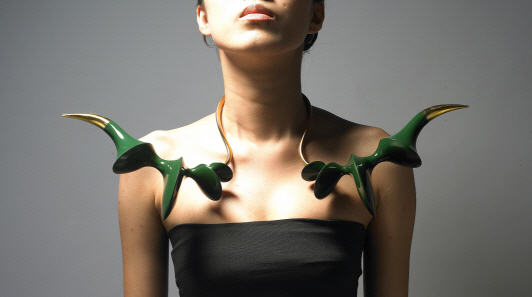Jewelry emerges as independent art genre
이 글자크기로 변경됩니다.
(예시) 가장 빠른 뉴스가 있고 다양한 정보, 쌍방향 소통이 숨쉬는 다음뉴스를 만나보세요. 다음뉴스는 국내외 주요이슈와 실시간 속보, 문화생활 및 다양한 분야의 뉴스를 입체적으로 전달하고 있습니다.
|
|
"An Attack by Green Horns," a neckpiece by Yoon Sang-hee (National Museum of Modern and Contemporary Art, Korea) |
Many consider jewelry as merely an accessory, but a recently opened exhibition shows that it can also be art.
Conceptual and experimental designs look very little like the everyday accessories worn by people today, but they have been recognized as works of art since the mid-20th century in the international art world.
"Ornament and Illusion: Spectrum of Contemporary Jewelry" is the first jewelry exhibition organized by the National Museum of Modern and Contemporary Art, Korea.
"As art, jewelry is not a familiar practice. But jewelry artists express their ideas and statements, challenging existing methods and forms," said Jeon Yong-il, a professor from the department of metalwork and jewelry at Kookmin University, at a guided tour of the exhibition last week.
The exhibition features about 170 works by 44 artists, exploring materials, aesthetics, narratives and techniques of contemporary jewelry designs.
What sets today's jewelry designs apart from traditional jewelry is the materials and how artists' ideas are incorporated into them.
Contemporary jewelry artists use unconventional materials such as paper, wood, clay, fabric and plastics. Korean artists also incorporate some traditional Korean craftsmanship into contemporary art jewelry such as the Korean enamel craft skill "chilbo" as seen in Kim Yu-ra's brooch "Raindrop Enamel" or mulberry paper, leather and lacquerware.
|
|
"Raindrop Enamel I," silver enamel on copper by Kim Yu-ra (National Museum of Modern and Contemporary Art, Korea) |
Jeon noted that Korean contemporary jewelry is a relatively recent development. "The field of Korean contemporary jewelry began in the 1980s, led by first-generation metal smiths who had gone abroad and learned Western metalworking techniques," wrote Jeon in an essay for exhibition.
Materials are more diverse ― ranging from natural materials to synthesized chemical materials and found objects and photography. Environmentally conscious artist Lee Jeong-hwa creates a thought-provoking image of a shark whose fin is being cut off with the phrase "easy cut," taken from the top part of a coffee mix packet.
As opposed to traditional jewelry, which focuses primarily on techniques and ornaments, contemporary jewelry expresses the inner psychology of the artists and pursues abstract concepts. The abstract designs often render them unsuitable to wear, but the experimental approach is slowly changing how people view jewelry as an independent art genre.
"The concept of jewelry as art is gradually taking hold. With the rise of cheap, mass-produced accessories and objects, metalwork has begun to lose some of the distinction that comes from its claim to advanced craftsmanship. But this shift has been tempered by the rise of contemporary jewelry as the representative genre in the field of metalwork," said Jeon.
The exhibition continues through Feb. 28, 2014, at the Gwacheon branch of the NMCA. For more information, call (02) 2188-6114 or visit www.mmca.go.kr.
By Lee Woo-young ( wylee@heraldcorp.com)< ⓒKoreaHerald(www.koreaherald.com)무단전재 및 재배포 금지 >
Copyright © 코리아헤럴드. 무단전재 및 재배포 금지.

